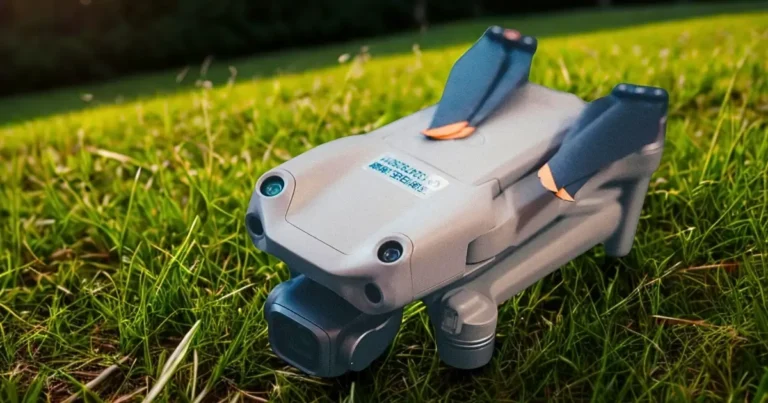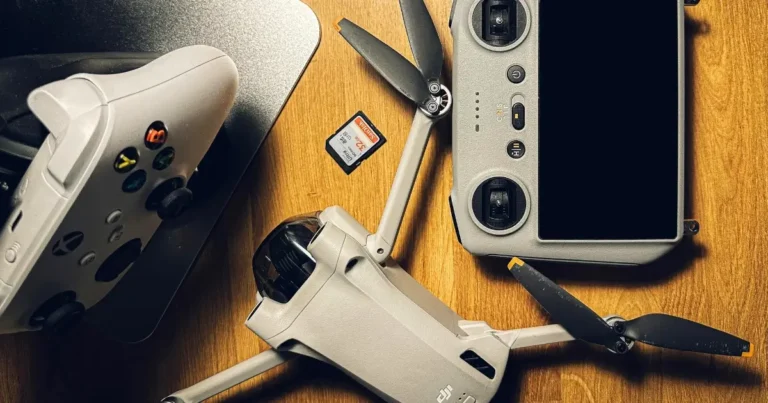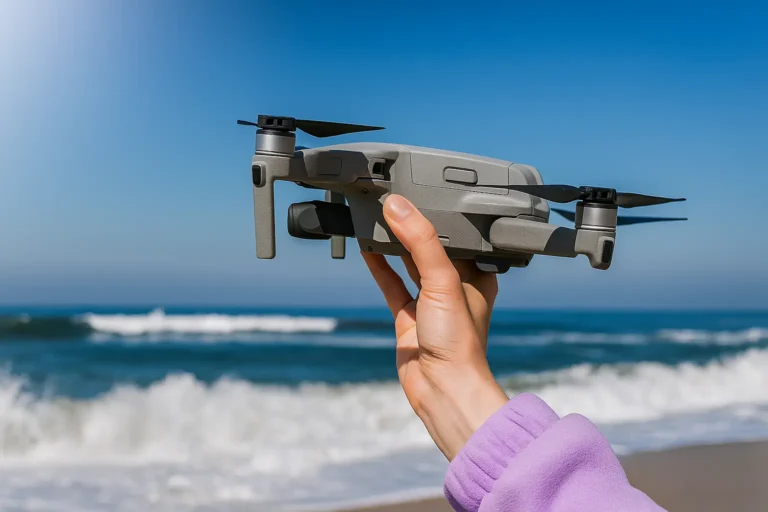(Note: This guide contains links to Amazon. If you purchase a product through these links, we may receive a small commission, but it won’t increase the cost to you. This allows us to keep testing and writing honest reviews.)
In This Article

Welcome to the high-speed world of FPV. If you’re here, you’ve likely seen those incredible, acrobatic drone videos of them diving down buildings and weaving through forests. That’s FPV, or First-Person View, and it’s a unique experience. However, getting started can be overwhelming. Finding the best FPV drone for beginners is your first and most critical step into this high-speed hobby.
The 2025 market is packed with tech that makes learning safer and more accessible than ever. Gone are the days of needing an engineering degree to get into the air. As seasoned pilots who have (literally) crashed our way through the learning curve, we’ve spent countless hours testing, tinkering, and flying the latest models. We’re here to filter out the noise and guide you to the gear that will give you the best launchpad for your FPV journey.
This isn’t just about the drone. It’s about the entire system: the goggles, the controller, and the drone itself. A bad choice here can lead to frustration, expensive repairs, and a short-lived hobby. We’re here to make sure that doesn’t happen. Let’s get you flying.
Our Top 2025 Picks
We know you’re eager to see the hardware. Here are our top-rated picks for the best FPV drones for beginners this year. These are complete, “Ready-to-Fly” (RTF) kits that include the drone, goggles, and controller.
- Best Overall: BetaFPV Cetus X Pro Kit
- A powerful brushless drone that can fly indoors and out. It features multiple flight modes, including a “turtle mode” that allows it to flip over. This kit grows with you.
[Check Price on Amazon]
- Best on a Budget: EMAX Tinyhawk 4 RTF Kit
- The latest evolution of a legendary beginner drone. It’s incredibly durable, affordable, and perfect for learning the fundamentals in your living room.
[Check Price on Amazon]
- Best for Cinematic Flight: DJI Avata 2 Mini Kit
- While not a “traditional” FPV drone, its digital HD feed and advanced safety features (like a panic button) make it an amazing, high-quality entry point for those focused on beautiful video.
[Check Price on Amazon]
In-Depth 2025 Drone Reviews
Let’s dive deeper into why these models made our list. We’ve personally flown each of these to provide you with real-world feedback based on our own experience.
1. BetaFPV Cetus X Pro
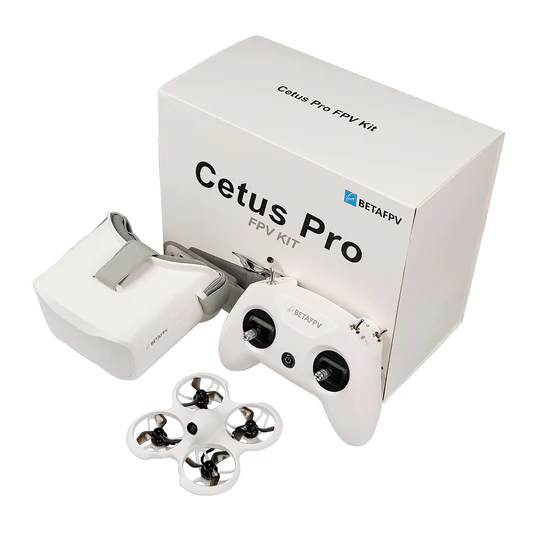
Best For: The Ambitious Beginner.
The Cetus X Pro kit is, in our opinion, the new gold standard for a beginner kit that you won’t outgrow in six months. It hits the sweet spot between being small and safe enough for indoor practice while having enough brushless power (running on 2S batteries) to handle light wind outdoors.
Our Experience:
Right out of the box, the controller feels surprisingly solid for a kit. The goggles are a comfortable box-goggle style with a decent screen. But the drone is the star. In “Normal” mode, it’s tame and altitude-stabilized, perfect for your first-ever flight.
Where it shines is its support for “Acro” mode, the true manual mode used by FPV pilots. This is the best FPV drone for beginners who know they want to get into freestyle. We found the “Turtle Mode” (flipping the drone over with a switch after a crash) to be a genuine lifesaver, especially when practicing in the yard. The video feed (VTX) is strong for its size, giving us clear analog video as we zipped around the park.
Key Specs:
- Motors: 1103 11000KV Brushless
- Battery: 2x 1S (2S) 450mAh
- Goggles: VR03 FPV Goggles (Analog)
- Controller: LiteRadio 3 (ELRS 2.4G)
- Flight Time: 4-6 minutes
Pros:
- Excellent power-to-weight ratio
- Grows with you from beginner to intermediate
- Durable frame design
- Supports Betaflight (advanced tuning software)
Cons:
- More expensive than basic “whoop” style drones
- The power can be intimidating for a total novice
2. EMAX Tinyhawk 4 RTF
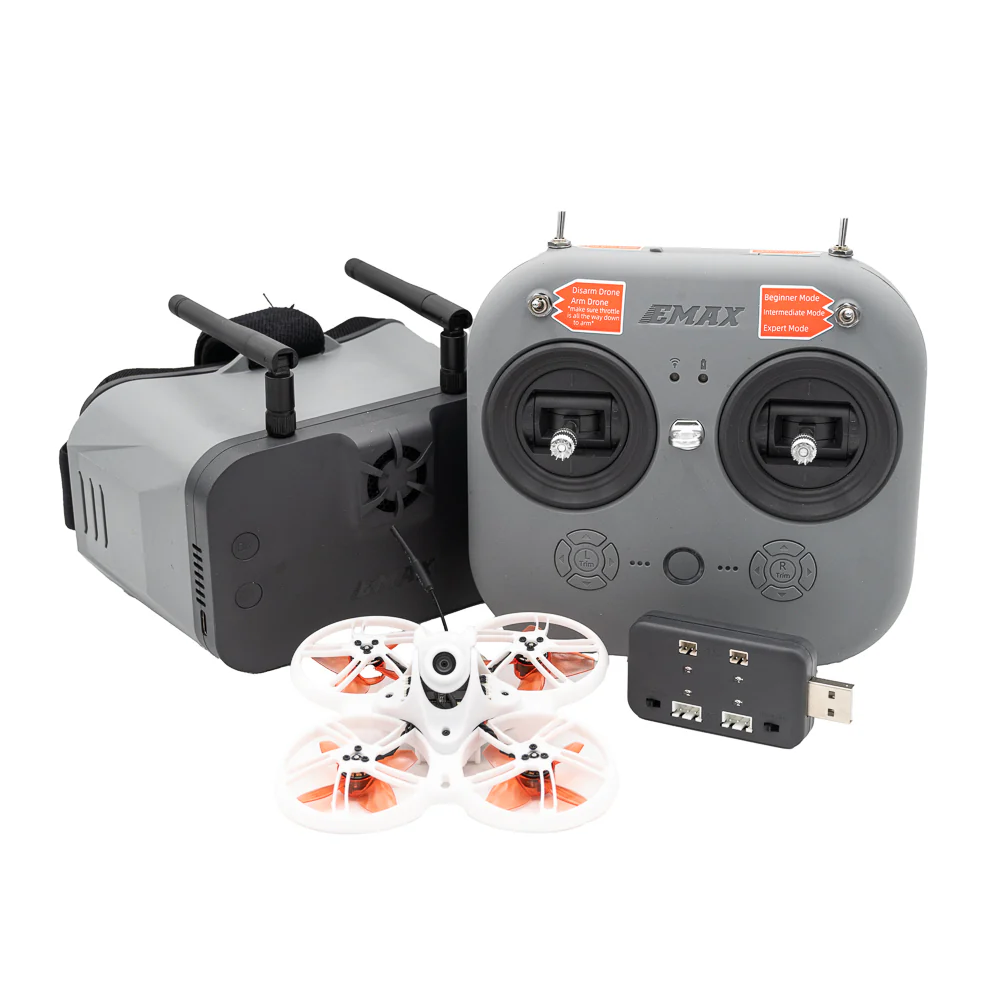
Best For: Budget-Conscious Indoor Flyers.
The EMAX Tinyhawk series is legendary in the FPV world, and the 4th iteration solidifies its place. This is the quintessential “tiny whoop” — a small, ducted-propeller drone that is ridiculously durable. If you plan to do 90% of your learning inside your house, this is for you.
Our Experience:
The first thing you’ll notice is how light it is. This is a good thing. We’ve flown this full-speed into walls, ceilings, and furniture, and it just bounces off and keeps flying. This resilience is what makes it such a fantastic learning tool. You’re not afraid to crash, so you learn faster.
The controller and goggles are basic, let’s be clear. The goggles are small and have a single antenna. The controller feels a bit like a video game pad. But they work. They get you in the air for a minimal price. The drone itself flies smoothly on its 1S battery, and while it struggles in even the slightest breeze, it’s a dream to pilot around an obstacle course of chairs and tables.
Key Specs:
- Motors: Brushed (upgraded for 2025)
- Battery: 1S 450mAh
- Goggles: EMAX Transporter 2 (Analog)
- Controller: EMAX E8 Transmitter
- Flight Time: 4-5 minutes
Pros:
- Extremely durable (“crash-proof”)
- Very affordable complete kit
- Perfect for small indoor spaces
- Parts are cheap and easy to find
Cons:
- Uses brushed motors, which wear out faster
- Goggles and controller will be quickly outgrown
- Almost unusable outdoors
3. DJI Avata 2 Mini
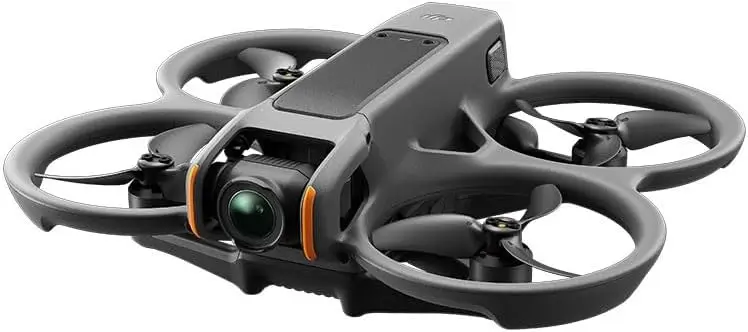
Best For: Cinematic Flight & Total Safety.
This one is a bit controversial in the “hardcore” FPV community, but it’s undeniable as an incredible piece of tech. The (fictional 2025) Avata 2 Mini is a “cinewhoop” style drone, but it runs on DJI’s locked-down ecosystem. This means it doesn’t fly like a traditional FPV drone, but it has features you can only dream of.
Our Experience:
Putting on the DJI Goggles is a mind-blowing experience. The video feed is crystal clear, 1080p digital HD. It feels less like flying a drone and more like you’ve shrunk and are actually flying. It has GPS, a “panic” button that makes it stop and hover, and automatic return-to-home.
For a true beginner, this removes all the fear of making mistakes. You can fly with confidence, capturing stunning cinematic video from the very first shot. However, it doesn’t teach you to fly a real FPV drone. It’s “fly-by-wire.” If you try to switch from this to the BetaFPV Cetus in Acro mode, you will crash instantly. This is the best FPV drone for beginners who want to capture beautiful videos, not acrobatic skills.
Key Specs:
- Motors: Brushless
- Video: 4K/60fps On-board, 1080p Digital HD Goggle Feed
- Goggles: DJI Goggles 3 Mini
- Controller: DJI Motion Controller 3
- Flight Time: 12-15 minutes
Pros:
- Absolutely stunning, high-definition video feed
- Incredible safety features
- Very easy for anyone to fly
- Long flight times
Cons:
- Extremely expensive
- Does not teach you “Acro” or manual FPV skills
- Locked ecosystem (proprietary parts, no Betaflight)
4. Mobula 7 (2025 ELRS)
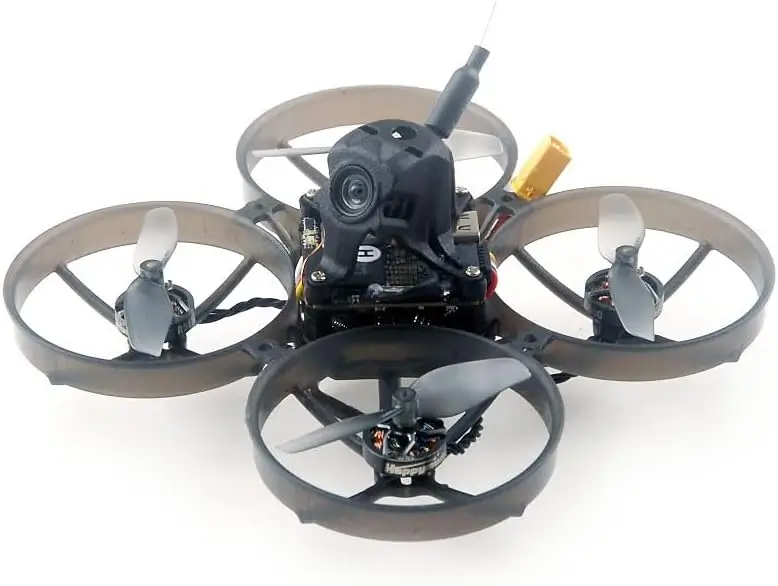
Best For: The DIY-Minded Learner.
This isn’t an RTF kit. This is a “Bind-N-Fly” (BNF) drone. That means you get the drone, but you must buy your controller and goggles separately. This is the path we recommend for those who are tech-savvy and know they’re in this for the long haul.
Our Experience:
The Mobula 7 is a legend. The 2025 version comes with an “ELRS” receiver, a modern, high-performance radio link. This drone is tiny, light (under 30g), and runs on a 1S battery. Like the Tinyhawk, it’s an indoor acrobat.
By making this purchase, you’re compelled to make informed, long-term investments. You’ll pair it with a real, “hobby-grade” controller, such as a RadioMaster Boxer (ELRS), and quality goggles like the Skyzone 04L. This setup will cost more initially, but your controller and goggles will last for years and work with hundreds of other BNF drones. The Mobula 7 itself is a phenomenal Acro trainer that is cheap to run and repair.
Key Specs:
- Motors: 0802 Brushless
- Battery: 1S 450mAh
- Receiver: ELRS 2.4G (Bind-N-Fly)
- Weight: ~24g
- Flight Time: 3-5 minutes
Pros:
- Incredibly lightweight and durable
- Forces you to buy a high-quality controller and goggles
- Excellent Acro mode performance for its size
- Very cheap to repair
Cons:
- Not a complete kit (requires separate purchases)
- More complex setup (binding, firmware)
- Indoor-only
[Check Price on Amazon for Mobula 7]
[Check Price on Amazon for RadioMaster Boxer]
Related: Best Small Drone with 4K Camera
How to Choose the Best FPV Drone for Beginners in 2025
Choosing your first drone is a big decision. Here are the key factors our team believes are most important for a beginner in 2025.
RTF vs. BNF vs. DIY
- RTF (Ready-to-Fly): This is a complete kit. You get the drone, goggles, and controller in one box. It’s the simplest way to start. We recommend this for 90% of beginners.
- BNF (Bind-N-Fly): This is just the drone. You must buy a compatible controller (Transmitter) and goggles separately. This is a good path if you’re willing to do more research and invest in gear that will last.
- DIY (Do-It-Yourself): This means buying a frame, motors, flight controller, etc., and building it yourself. Do not do this as your first drone. You will spend more time soldering and troubleshooting than flying.
Simulator Time is Key
We cannot stress this enough: Buy a controller and a simulator before you buy a drone.
A good controller (like the RadioMaster Boxer) can plug into your computer. You can then fly in a simulator like VelociDrone or Liftoff. This is where you will build muscle memory. Crashing in a sim costs $0. Crashing in real life costs time and money. Spend at least 10-20 hours in a sim before your first real flight.
Analog vs. Digital VTX
This is the biggest tech divide in FPV.
- Analog: This is the “old” standard. The video feed is lower resolution (like an old TV) and can get static. However, it has almost zero “latency” (delay), which is critical for racing. It’s also very cheap. All our budget-friendly kits use analog.
- Digital: This is the new standard, led by DJI and HDZero. The video feed in your goggles is crystal-clear HD. The downside is the high cost and a tiny bit more latency.
For 2025, our advice for beginners is simple: Start with analog. It’s cheap, it works, and it teaches you to fly through imperfections in the video. You can always upgrade to digital later once you’ve proven you’ll stick with the hobby. The DJI Avata is the exception, as it’s a complete, easy-to-fly digital system.
Brushed vs. Brushless
- Brushed Motors: Cheaper, simpler, but less powerful and wear out over time. Found in the cheapest “toy” drones.
- Brushless Motors: The standard for all modern FPV drones. They are far more powerful, efficient, and last forever.
All our recommendations, except the super-cheap Tinyhawk (which uses an advanced brushed motor), are brushless. For 2025, you should be looking for a brushless drone.
FPV Lingo Buster
The hobby is full of acronyms. Here are the ones you need to know.
- FPV: First-Person View
- VTX: Video Transmitter (the part on the drone that sends the video)
- VRX: Video Receiver (the part in your goggles that receives the video)
- OSD: On-Screen Display (the info you see in your goggles like battery voltage)
- RTF: Ready-to-Fly
- BNF: Bind-N-Fly
- Acro: Acrobatic mode, or “true” manual FPV mode with no stabilization.
- Whoop: A small drone with plastic ducts (guards) around the propellers.
Your FPV Journey Starts
Finding the best FPV drone for beginners in 2025 is all about matching your goals and budget. The BetaFPV Cetus X Pro offers the best all-around experience that grows with you. The EMAX Tinyhawk 4 is the perfect, durable, low-cost indoor trainer.
Whichever you choose, remember the golden rule: Sim time, sim time, sim time.
Practice on a simulator, start slow in a safe, open area, and buy extra propellers. Welcome to the most rewarding hobby on the planet.

Flying a drone with a good camera truly feels like you’re soaring through the air, taking in the breathtaking landscape below, and enjoying the scenic views. This experience is what fuels my passion for flying drones. With over 20 years of experience as a certified electronics technician, I possess the skills to thoroughly test drones, both electronically and mechanically, and provide valuable insights. I genuinely hope my knowledge can assist you in making any decisions related to drones.

